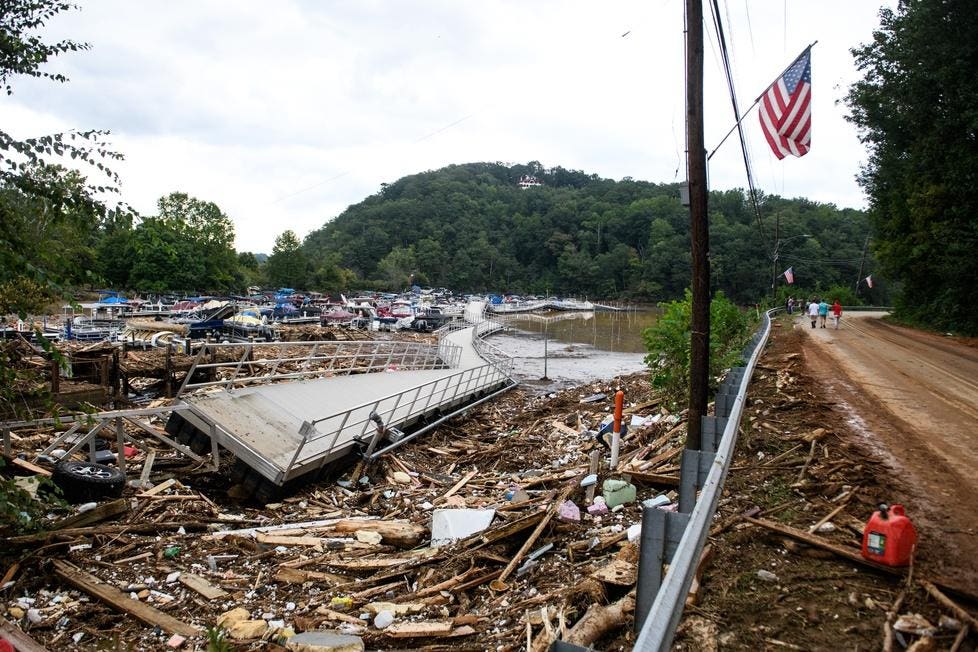LAKE LURE, NORTH CAROLINA – SEPTEMBER 28: The Rocky Broad River flows into Lake Lure and overflows the town with debris from Chimney Rock, North Carolina after heavy rains from Hurricane Helene on September 28, 2024, in Lake Lure, North Carolina. Approximately six feet of debris piled on the bridge from Lake Lure to Chimney Rock, blocking access. (Photo by Melissa Sue Gerrits/Getty Images)
Getty Images
When supply chain practitioners think about forecasting, they focus on demand forecasting. Demand forecasting is essential, but the number of different forecasts that an effective organization should use is much larger. Different types of forecasts are required for procurement, replenishment, financial planning, strategic planning, and achieving environmental, social, and governance (ESG) goals. Weather forecasting can play a role in all of these different types of forecasts.
Weather and Store Replenishment
Weather forecasts are an underused component of demand management programs. RELEX Solutions, one of the leading supply chain software companies in Europe, has a solution for helping grocery and other retailers improve their short-term demand forecasts and store replenishment. For example, imagine that the first heat wave of the year is due to hit a regional cluster of grocery chains’ stores the following weekend. Local shoppers will stream in to pick up beer, hamburger fixings, and bags of charcoal to kick off the first proper cookout of the season. The inventory team’s ability to accurately predict and prepare for the impact of this weather forecast will mean the difference between capitalizing on an increased sales opportunity.
RELEX points out that different types of weather events impact retail demand. “Think not just about bright and sunny cookout weather, but also unbearable heatwave weather, unbreaking drizzle weather, torrential downpour weather, crisp autumnal weather, snow flurry weather, ice storm weather, and every other type of weather that could possibly impact your stores’ demand. Then consider each product across your entire assortment. Will demand for your rain boots be as reactive to the rainy season as it will be for your umbrellas? What about raincoats? Light-weight ponchos? Waterproof hats vs normal ball caps? Socks? Frozen mixed vegetables?”
Different SKUs and product families react differently to different types of weather events. “There are an enormous number of different weather factors that will affect different stores across your network on any given day, creating different impacts on different items across your assortment.” Further, not all weather is actually impactful. “In grocery retail, for example, day-to-variation in temperature, cloud cover, or rainfall are unlikely to impact sales forecasts because people have to eat no matter what. The challenge, then, is to automatically identify the specific combinations of factors that will actually impact demand.”
In short, the math gets really complex really fast. This solution needs to utilize machine learning. Machine learning relies on history; retailers need to realize that the replenishment forecasts will get more accurate over time.
Weather Forecasting and Supply Chain Risk Resilience
Weather forecasts have been used to improve risk management for decades. As real-time risk management solutions have become more mainstream, the ability to utilize these forecasts across a multi-tier supply chain has significantly improved. These solutions are looking at all kinds of events that can adversely impact a supply chain – port strikes, a fire at an upstream factory, and, of course, severe weather events.
A classic example of this was demonstrated by Cooper Health. Cooper University Health Care is the leading academic health system in southern New Jersey. Cooper Health uses a supply chain risk solution from Interos. Thomas Runkle, the vice president of their supply chain, noted that in the summer of 2023, “a hurricane was coming up through the Gulf and across the Panhandle of Florida.” The Interos solution “showed us we had four vendors that were in the path of the hurricane. And we reached out to them ahead of time and asked each of them, ‘are you planning on shutting down? Is the hurricane going to disrupt your ability to get us our supplies? Three of the four were OK. One of them said, ‘yeah, we’re shutting down this afternoon.’ We were able to put in a orders for a couple days’ worth of supplies before they shut down that afternoon.”
The more concentrated key suppliers are in a particular region, and the bigger the event, such as the catastrophic rainfall following Hurricane Helene, the more critical these types of solutions become and the more difficult it is to mitigate all impacts completely.
Everstream Analytics is another supplier offering a real-time risk solution. Everstream has hired a team of 5 meteorologists to improve its solution. Jon Davis is their chief meteorologist. Mr. Davis points out that for disaster forecasting, which is focused on a point on a map, the forecasts are pretty good for 15 days. The forecasts, of course, get better as the days pass.
On their platform, all their gridded data is disseminated 15 days in advance on an hourly basis. “So, you can pick any point on the globe, and you can get 15 days of hourly temperatures, precipitation, cloud cover, so on and so forth.” The solution allows for zooming out. So, for example, the weather forecast at a particular plant can be viewed. Alternatively, you can look at the forecast for all suppliers located near that factory.
Longer Term Weather Forecasts and Procurement
Mr. Davis points out that while supply chain organizations traditionally employ short-term weather forecasts, long-term forecasts are also critical in several areas.
When you move beyond a forecast for a point on a map to a broader geographical area, for example, tropical activity in the Gulf of Mexico or weather conditions across Central Europe, then forecasts go out much longer than 15 days. This intraseasonal forecasting is done in six-week blocks.
“We’re doing research right now on the fall and the winter across the US, across Europe, across East Asia, for energy concerns.” These companies want to know what the winter looks like. Is it going to be on the cold side? The warm side? How will that affect energy demand? For a cold winter, utilities might want to enter long-term procurement contracts for energy inputs before the costs rise or engage in hedging.
For a food company that generally procures corn from Iowa, if weather forecasts show a hot, dry summer for that part of the country, yields will be affected. The company might have trouble getting all the supplies it needs. In this case, it might seek to find new suppliers in other regions.
Mr. Davis says their clients report a good return on investment on their solution. One of their clients looked back over the years before they started using the Everstream forecasts. Many of the procurement decisions were made too late, well after a crop was already harvested. Then, over the last couple of years, after they began working with Everstream, they looked at the ROI associated with making their decisions earlier. While the company did not disclose the exact savings to Everstream, it did admit to saving a substantial amount of money. Importantly, they saved that money in years with both good and bad yields. This was because even if the yield in aggregate for a continent is good, there can still be regions in that continent with poor yields.
The weather also affects milk production. Hot weather stresses cows and affects how much milk they produce.
Crop forecasts have traditionally been used for forecasting row crops – soybeans, corn, cocoa, and nuts. Everstream is developing models for forecasting tree crops. The greatest initial interest is for forecasts for coffee yields. Mr. Davis explained that they have built a model that forecasts yields in different states in Brazil. There are two different time frames within the model. One model looks at the current crop. How has that crop flowered, developed, and matured?
They also have a model focused on the following year that looks at tree health. Poor tree health, of course, leads to poor yields. There can be winter freezes that affect the trees. Then, following what is typically a dry winter, the new rainy season starts in October and November. The rainfall in those months is critical for the flowering of the new crop.
Don’t Forget Strategic Planning!
The strategic planning team can use even longer-term forecasts. Here, Everstream is looking at weather trends that will occur over the rest of this decade, the next decade, and the decade after that. One of Everstream’s food clients wants to know about agricultural yields across Europe over the next couple of decades. This affects long-term sourcing strategies.
Mr. Davis points out that sustainability groups within companies can also derive value from weather forecasts that occur within the strategic planning time horizon. For example, if a European food company is procuring in Europe and the yields will go down over time, that company will need to procure more of those foodstuffs from other areas. But how will sourcing from South or North America affect their carbon footprint?
The Science Associated with Yield Forecasts
Everstream has seven different data sources. The obvious ones are for temperature, precipitation, humidity, and wind. But, Mr. Davis points out, it is not just a matter of whether there will be rain in the coming few weeks, but how persistent the heat and rainfall will be over the longer-term. “Persistence of temperatures and precipitation is really important for crops overall.”
Everstream also brings in data on soil moisture at “a very granular level. We bring in VHi -the vegetative health indices.” All of these data sets are pulled together, and a week-by-week history of weather and yields is constructed. That history typically spans 10 years, but can sometimes extend as long as 20 years. Once the history has been built, they apply machine learning to build yield forecast models. The model learns. Rainfall during planting is not a good thing. Rainfall during the vegetative phases is a really good thing, unless it’s extremely heavy rainfall during harvest. What constitutes “heavy” rain or “extremely” hot weather depends upon the crop. Everstream has built these models for 200 different types of crops.
How good are Everstreams’ forecasts? We can test them. Mr. Davis is forecasting a very poor foliage season in New England. “The whole Northeast has had an incredibly dry over the last 60 to 90 days. One of the driest last 60 days, going back over 100 years. That is really poor for color. “If you have a trip planned in Vermont coming up in early October, you may want to think about going elsewhere.” AccuWeather, in contrast, is forecasting vibrant colors across much of the region.









